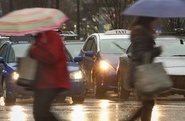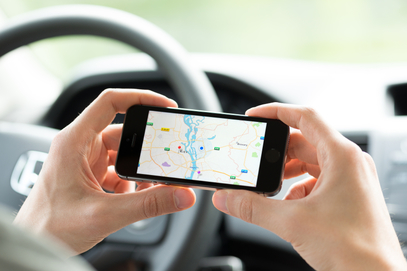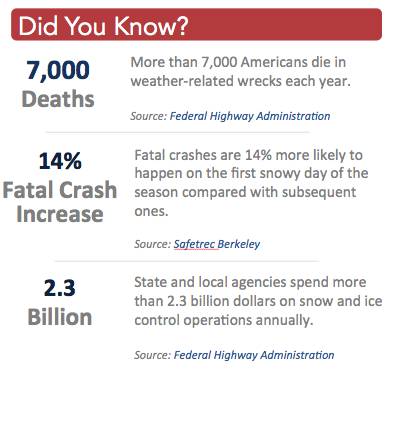Top 10 Safety Tips for Driving in Bad Weather
Minimizing the Risk of a Car Accident in Bad Weather
Driving safely in Portland can be a challenge for even the most cautious drivers. Add heavy rain and early morning fog into an already congested driving environment, and the chance of a car crash increases substantially.
National Highway Traffic Safety Administration (NHTSA) statistics indicate that 25% of all automobile crashes are weather related, and that 74% of these crashes happen on wet pavement, caused by rain, snow, sleet, ice, or fog.
I was surprised to learn that driving during a rainstorm has a higher incidence of weather-related crashes at 46% than driving during a snow storm 17% or icy conditions at 12%. Drivers understand that snow and ice require lower speeds and longer breaking distances, but seem to accept rainy conditions as somewhat “normal.”
Stopping Distance Doubles in Rainy Conditions and Quadruples for Snow
During a light rain a car’s traction and maneuverability are greatly affected. Heavier rains can also diminish visibility distances and perception. If the pavement is wet, then the friction between the roadway and your car tires will decrease by 50%! Snowy conditions can decrease the friction by 75%. This means the braking distance required to stop your vehicle doubles during a light rain, and quadruples in snowy conditions.
If You Double Your Speed, Then Your Stopping Distance Quadruples

Top 10 Tips for Safe Driving in Bad Weather Conditions
Below I have outlined 10 precautions you should take to minimize the risks of driving in bad weather:
1. Slow Down. The single most beneficial action you can take to minimize the risk of a car accident in bad weather is to slow down. For example, reducing your speed from 60-mph to 40-mph lowers your stopping distance on a wet surface from 459 ft. to 204 ft. (a 55% reduction)!
2. Increase the following distance between your car and the car ahead of you. Adhere to a minimum of 2-3 seconds between cars for normal driving conditions (good tires, dry pavement, day-time, etc.). In less than perfect conditions (light fog, rain, or night-time driving) increase following distance to 4 seconds. In extreme weather conditions (heavy rain, dense fog, snow, or ice) increase to 6+ seconds. When you think about it, allowing more distance between cars does not increase travel time to your destination, but it does reduce your chances of being involved in a rear-end collision.
3. Be seen by others — increase your car’s visibility. Be sure your vehicle’s lights are functioning. Studies have shown that driving with your “low beam” headlights on (not your parking lights), can significantly reduce potential automobile accidents up to 38%. In Oregon, headlights are required to be on when driving from sunset to sunrise, or when visibility is less than 1,000 ft. (fog, rain, snow, etc).
Another option is to drive with hazard lights ON. Oregon permits driving with your hazard lights blinking, but in many other states it is illegal. The rationale is that it could confuse other drivers who might interpret the blinking lights as a turn signal, especially if viewed in a rear-view mirror. Hazard lights are supposed to indicate the presence of a vehicular traffic hazard such as a stopped car blocking a traffic lane. This method should only be used for very severe conditions with low visibility.
4. Minimize abrupt actions. Making abrupt actions such as hard or panic braking, quick lane changes, and high-speed merging during bad weather increases your chances of losing control of your vehicle. It is much better to drive in a smooth, controlled manner to maintain control. Most roads are crowned in the middle, which means in heavy rain the water will run off to the sides. If possible stay toward the middle of the road to avoid deep standing puddles, which could cause your car to hydroplane, loose control and possibly crash.
5. Increase caution and awareness at locations where vehicle accidents typically occur – intersections, bridges, lane changes, and merges. Pay special attention to bicyclists and pedestrians who may be forced to share the road with you. Not paying attention in these high-risk areas will certainly increase the chances of hitting another vehicle, bicycle or pedestrian. Many pedestrian accidents often result in serious personal injury including head trauma and traumatic brain injury.
Portland has an abundance of bicyclists. The city has dedicated huge amounts of money to making Portland’s roads bicycle friendly. Drivers should be on alert for adjacent bicycle lanes and when approaching intersections. Bicycle accidents commonly occur when a driver makes a right turn at an intersection and collides with the bicyclist in the adjacent bike lane on the driver’s passenger side. This is commonly referred to as a “right hook.” Another common bicycle accident occurs when a driver makes a left turn at an intersection and collides with the cyclist in the oncoming bicycle lane who is proceeding through the intersection on a green light and with the right-of-way. This is called a “left hook.” Being aware of these common accident patterns can drastically reduce the chance of causing an accident.

7. Use your car’s technology to effectively control the vehicle. For many years, automakers have utilized technology to enhance the vehicle’s ability to maintain control and safety while driving in poor weather conditions. You know these features as electronic stability control, traction control, anti-lock brakes, four-wheel drive, active body control, freeze detectors, fluid level monitors, accident avoidance, and telematics. While some of these features are automatically “active” when you are driving, others are not and must be turned ON. Be sure you understand how to turn on your stability control or “Traction Control” features in bad weather. In addition, your need to know how to use/operate features such as anti-lock brakes for effective operation. You should apply constant even pressure for anti-lock brakes to work. Do not “pump” the brakes.
A special note about “telematic” systems like GM’s OnStar. For the subscription price of about $20/mo, you can have access to emergency aid on request at the touch of a button, and in the event the airbags deploy, the system automatically notifies the dispatch center, locates the vehicle, and summons emergency service, if the driver does not respond to a phone-based inquiry.
8. Understand your driving limitations. As we age our ability to drive safely becomes complicated because of vision limitations, slower reaction times, ability to judge distances, and confusion over directions. In our family, an 80+ year old family member made the decision to stop driving because she “got lost” and could not figure out how to return home. We will all face the decision to “curtail” our driving and eventually stop – hopefully before a motor vehicle accident becomes the wake-up call.
9. Stay on top of your car’s condition. Always prepare and check your vehicle’s tires, fluids, battery, wipers and window washer. In addition, always keep an emergency kit and cell phone in your vehicle.

To listen to the latest travel conditions by phone, simply dial 511, or toll free 800.977.6368. The system will allow you to speak navigation commands for the menus and provide the latest information on road conditions by highway or in major cities, and any alerts.
TripCheck Mobile. From your smart phone you can access ODOT’s travel information website and receive alerts, incident notifications about road closures, traffic speeds, and camera pictures. Simply login to http://www.tripcheck.com/mobile.
Use the weather app on a smart phone or simply go to www.weather.com to get updates on local weather.
What To Do After A Car Accident in Portland

Read Oregon Car Insurance and Personal Injury Claims FAQs

